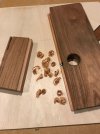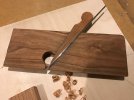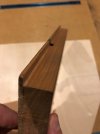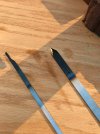I'm still tooling up to make real moulding planes, but after seeing @creasman post his completed snipe's bills the other day, I was motivated to just make something. I ended up making a strange specialty plane that I am not sure I have seen anywhere before.
The plane cuts an 1/8" wide groove approximately 1/4" deep, but the unique thing is that the groove's side is flush with the reference surface the plane rides on. I am going to use this with a sort of tilted platform to cut the recess for boxing in wooden planes. Since it cuts a groove flush with the reference surface, you can run a rabbet plane on the tilted platform first to create a shoulder on the plane billet, and then use this plane to create the deeper recess needed for shoulder boxing, like you can see in Caleb James' rabbet plane plans or Matt Bickford's rabbet planes.
You could accomplish that with a router table or a table saw, or even just a rabbet plane and a plow if you can really hold the plow at a consistent tilt to the workpiece, but this was a fun project and is very quick and quiet to use. There is very limited setup required, too. Most of the setup will be in making a platform for it to ride on that matches the desired angle and placement of the boxing for a given billet thickness.
Some random details about the plane:
The plane cuts an 1/8" wide groove approximately 1/4" deep, but the unique thing is that the groove's side is flush with the reference surface the plane rides on. I am going to use this with a sort of tilted platform to cut the recess for boxing in wooden planes. Since it cuts a groove flush with the reference surface, you can run a rabbet plane on the tilted platform first to create a shoulder on the plane billet, and then use this plane to create the deeper recess needed for shoulder boxing, like you can see in Caleb James' rabbet plane plans or Matt Bickford's rabbet planes.
You could accomplish that with a router table or a table saw, or even just a rabbet plane and a plow if you can really hold the plow at a consistent tilt to the workpiece, but this was a fun project and is very quick and quiet to use. There is very limited setup required, too. Most of the setup will be in making a platform for it to ride on that matches the desired angle and placement of the boxing for a given billet thickness.
Some random details about the plane:
- I just made it out of a random piece of cherry, it is not quartersawn or anything. I just wanted to make something quick and dirty, not perfect.
- The blade is 1/8"x1/4"x8" O1 tool steel that necks down to 1/8"x1/8" on the business end, tapered on a 1x30 belt sander and hardened with just a propane torch, then tempered at 400 F for 2 hrs in a toaster oven. I thought I screwed up the hardening because I wasn't getting conclusive file skating after quenching, but once I tempered and sharpened it it seems perfectly fine. I was able to cut two 8" long full depth grooves in SYP and still shave arm hair with it, so whatever happened the steel sure isn't dead soft. I don't get huge burrs or wire edges when sharpening it like I would expect with soft steel.
- The blade projects about 0.010" from the side of the plane, and also from the other side of the skate.
- The design is sort of a hybrid between a Roubo moulding plane and a plow plane. I learned a lot about why plow planes are designed the way they are.
- The wedge has a compound angle on the breast like a Roubo moulding plane, so there's no tendency for it to pop out sideways.
- Cherry does not make a very durable skate, but it should be OK for what I need to make it do, since it doesn't have to take fine shavings. The final depth is set by the depth stop, not the skate, anyway. If I was to make another I would probably use a much harder wood for the skate, or maybe even metal. Mostly the problem is the cherry compresses easily when you only have a ~1/10th wide strip of it pressing against the work, and the edges of the skate splinter easily. It doesn't seem to be in danger of bending or snapping off, though.
- I get a little chatter taking thicker shavings -- there's probably not really enough support near the cutting edge -- but that is fine for what this needs to do. Usually the last pass cleans it up as it hits the depth stop.
- I don't know why I did this but the bed angle is 55 degrees. I don't think I would do that if I had to make it again, I would probably just do 45 for ease of cutting. Tear out at the bottom of the groove is irrelevant.
Attachments
Last edited:




